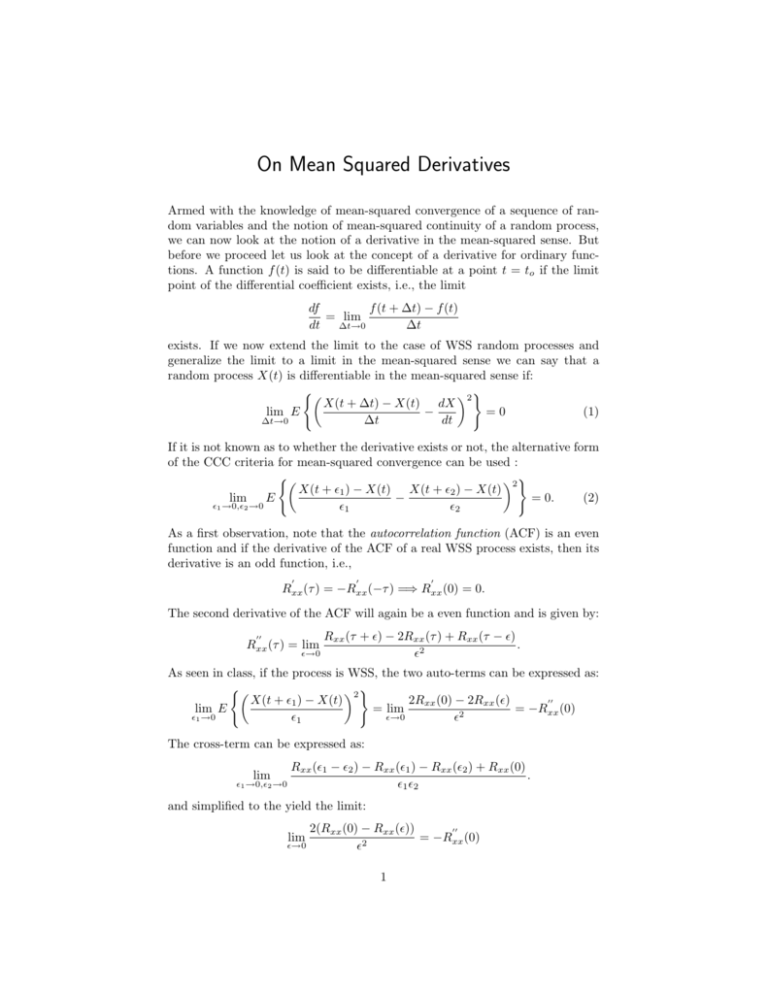On Mean Squared Derivatives
advertisement

On Mean Squared Derivatives
Armed with the knowledge of mean-squared convergence of a sequence of random variables and the notion of mean-squared continuity of a random process,
we can now look at the notion of a derivative in the mean-squared sense. But
before we proceed let us look at the concept of a derivative for ordinary functions. A function f (t) is said to be differentiable at a point t = to if the limit
point of the differential coefficient exists, i.e., the limit
f (t + ∆t) − f (t)
df
= lim
dt ∆t→0
∆t
exists. If we now extend the limit to the case of WSS random processes and
generalize the limit to a limit in the mean-squared sense we can say that a
random process X(t) is differentiable in the mean-squared sense if:
(
2 )
X(t + ∆t) − X(t) dX
lim E
−
=0
(1)
∆t→0
∆t
dt
If it is not known as to whether the derivative exists or not, the alternative form
of the CCC criteria for mean-squared convergence can be used :
(
2 )
X(t + 1 ) − X(t) X(t + 2 ) − X(t)
lim
E
−
= 0.
(2)
1 →0,2 →0
1
2
As a first observation, note that the autocorrelation function (ACF) is an even
function and if the derivative of the ACF of a real WSS process exists, then its
derivative is an odd function, i.e.,
0
0
0
Rxx (τ ) = −Rxx (−τ ) =⇒ Rxx (0) = 0.
The second derivative of the ACF will again be a even function and is given by:
00
Rxx (τ ) = lim
→0
Rxx (τ + ) − 2Rxx (τ ) + Rxx (τ − )
.
2
As seen in class, if the process is WSS, the two auto-terms can be expressed as:
(
2 )
00
X(t + 1 ) − X(t)
2Rxx (0) − 2Rxx ()
lim E
= lim
= −Rxx (0)
1 →0
→0
1
2
The cross-term can be expressed as:
lim
1 →0,2 →0
Rxx (1 − 2 ) − Rxx (1 ) − Rxx (2 ) + Rxx (0)
.
1 2
and simplified to the yield the limit:
00
2(Rxx (0) − Rxx ())
= −Rxx (0)
2
→0
lim
1
The requirement in Eq. (2) can then be checked as:
(
2 )
X(t + 1 ) − X(t) X(t + 2 ) − X(t)
lim E
−
=
1 ,2 →0
1
2
00
00
−2Rxx (0) + 2Rxx (0)
= 0.
Note that all we have assumed for this condition to be true is the existence of the
0
00
derivatives Rxx (τ ), Rxx (τ ) at the origin τ = 0. The existence of these derivatives at the origin therefore constitutes a sufficient conditions for the existence
of a mean-squared derivative. The most immediate consequence of the existence of the mean-squared derivative is that the operations of the mean-squared
differentiation and expectations commute, i.e.,
0
0
X(t + ∆t) − X(t)
= µx (t) = E{X (t)}
lim E
∆t→0
∆t
which is a fact that will be used quite a bit when we look at the transmission
of random processes through LTI systems.
In summary, we can infer a lot about the WSS random process from just
knowledge of its second-order statistics and specifically its ACF:
1. if the ACF decays to zero, then process is ergodic in the mean.
2. if the ACF is continuous at the origin and the process has finite average
power then the process is mean-squared continuous.
3. if the first and second-order derivatives of the ACF exist at the origin then
the process is mean-squared differentiable.
Specifically the limit in the mean-squared sense is useful for engineering applications, where we don’t have access to all sample realizations of the process and
all we have access to are the estimates of the first and second-order statistics.
2










